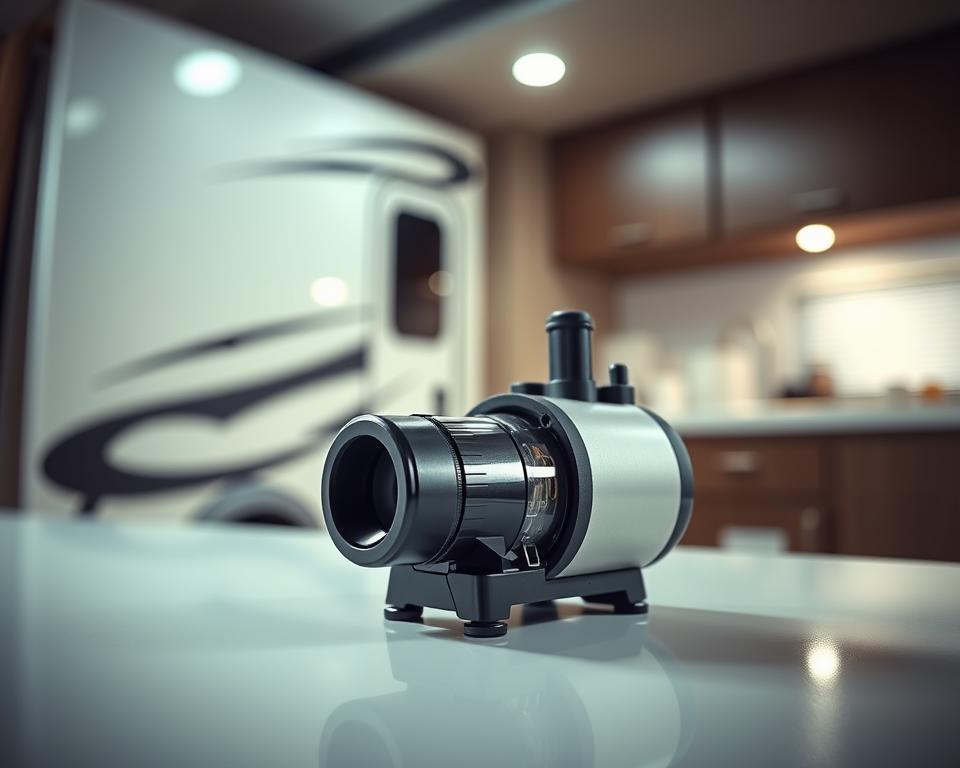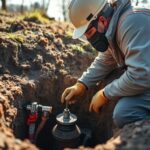Septic Air Pump: Comprehensive Guide for Property Owners
Do you sometimes think about what boosts your air-treated Septic system’s effectiveness? The Septic air pump is the often-overlooked hero crucial for your system. Throughout this overview, homeowners will get valuable information on the Septic air pump’s purpose. It’s key for a well-functioning, efficient Septic tank.
Grasping the necessity of a Septic tank air Pump can enhance your Septic system’s functionality using RV septic service. It also secures your property’s value and environmental health. The following guide will feature All in Sanitation, a well-regarded Septic industry leader. They’re prepared to meet your Septic aerator Pump demands.
Summary Highlights
- The Septic air Pump is vital for aerobic Septic systems.
- Looking after your Septic system air Pump can improve overall system performance.
- Regular checks lengthen the longevity of your Septic tank air Pump.
- Choosing the right Septic aerator Pump is key for maximum operation.
- All in Sanitation delivers dedicated services for Septic air Pump requirements.
Breaking Down Aerobic Septic Units
Aerobic Septic systems present a superior waste treatment option by using oxygen. This system consists of aerobic bacteria living in well-oxygenated environments. These bacteria are more efficient in breaking down organic matter. With the help of Septic aerator Pumps, these systems ensure a continuous oxygen supply, boosting the waste decomposition process.
These systems shine in lowering sludge buildup, because of the effectiveness of aerobic bacteria. This reduction in solid waste means minimal cleaning and tank Pump-outs is necessary. Additionally, they reliably process wastewater, resulting in reduced odors. This yields a improved environment for homeowners and the community alike.
To ensure these systems run smoothly, it’s important to know the key Septic system components. These include the Septic tank, aeration chamber, and effluent Pump. Each part plays an important part, especially the air Pump. It pushes oxygen into the tank, essential for the aerobic bacteria’s efficiency.
Significance of the Septic Air Pump
The Septic air Pump is pivotal in the performance of aerobic Septic systems. It operates as the system’s “lungs,” providing the necessary oxygen essential. This oxygen allows aerobic bacteria to thrive and digest waste properly. If the Pump breaks, the system’s performance drops, bringing about sludge buildup and possible odors.
Such issues can disrupt Septic system operations and lead to environmental hazards. By understanding how important the Septic air Pump is, homeowners can move early. They can maintain its best function through scheduled service. This prevents failures, sidesteps costly repairs, and keeps the aerobic system’s well-being.
Major Benefits of Using a Septic Air Pump
Employing a Septic air Pump notably enhances the performance of Septic systems. Septic air Pumps are vital as they speed up the breakdown of waste. This is accomplished by oxygenating the treatment process, encouraging aerobic bacteria growth. These bacteria are necessary for efficient waste treatment.
They’re also instrumental in reducing foul smells. Due to more active aerobic processes, waste decomposes faster, thus lessening odors. This ensures better surroundings for homeowners.
Another significant benefit is the reduction in sludge accumulation. Consequently, tanks demand less frequent Pumping, cutting both money and time. Enhanced processing not only cuts expenses but also prolongs the lifespan of the drain field.
Maintaining these Pumps properly means minimal repair costs and meeting regulatory standards. Thus, the upsides of Septic air Pumps go beyond being for homeowners. They also support environmental health by advancing waste management practices.
| Benefit | Description |
|---|---|
| Fast Waste Breakdown | Heightened aerobic activity quickens the decomposition process. |
| Minimized Odor Emissions | Better treatment efficacy produces fewer odors. |
| Reduced Sludge Buildup | Minimal Pumping and maintenance are required. |
| Extended Drain Field Life | Better treatment ensures a healthier drain field. |
| Cost Savings | Lower chance of repairs and regulatory compliance cost. |

Finding a Suitable Septic Air Pump
Choosing the proper Septic air Pump is critical for an effective aerobic system. Homeowners must consider various factors for the perfect selection. The capacity of the tank and the airflow demands matter greatly the Pump’s effectiveness.
To choose intelligently, it’s important to recognize the air Pumps available. There are mainly two types: diaphragm Pumps and rotary vane Pumps. Each delivers specific strengths, which should be paired with your home’s specific needs and how it operates.
Energy efficiency also is a factor. Opting for a Pump that cuts energy use while providing the needed airflow can result in meaningful reductions. Help from All in Sanitation experts can be invaluable. They confirm the Pump you choose meets your system’s requirements seamlessly.
Major Kinds of Septic Air Pumps
Homeowners can make better choices by understanding the different Septic air Pumps available. There are mainly two types: diaphragm Pumps and rotary vane Pumps. Each has its particular functions and benefits.
Diaphragm Pumps, valued for their silent operation, are popular for residential Septic systems. They deliver energy efficiency while providing steady air flow. Their trustworthy performance suits smaller systems, meeting the needs of many homeowners.
Rotary vane Pumps, however, are better suited for larger or commercial systems. These Pumps produce more power, needed for handling bigger loads. Their solid build delivers efficient operation in large-scale Septic systems.
| Type of Pump | Best Use | Advantages |
|---|---|---|
| Diaphragm Pumps | Residential Systems | Quiet operation, energy-efficient, reliable air flow |
| Rotary Vane Pumps | Larger or Commercial Systems | Powerful performance, high capacity, durable construction |
Knowing the contrasts in Septic air Pumps is essential for upgrades or replacements. Each Pump type brings particular attributes to address various needs. This provides top performance for any system.
Indicators You Require a Septic Air Pump Replacement
Homeowners must watch for Pump failure signs in their Septic systems. Some indicators suggest the need for a Septic air Pump replacement. These ensure continued performance. Spotting these promptly prevents serious issues.
Signs of potential problems include:
- Unusual noises from the Pump, like grinding or trembling, might show internal damage.
- A clear lack of air output means the Pump isn’t functioning properly, impacting efficiency.
- Frequent electrical problems, such as circuit trips or voltage drops, could point to overloading.
- Visible damage on the Pump unit, with fractures or leaks, demands quick action.
- Foul odors in the yard often signal a compromised Pump, showing ineffective effluent aeration.
Recognizing these signs early prevents expensive repairs or total system failure. Performing consistent assessments makes it easy to catch these issues. It also clarifies if you require a new Septic air Pump.
Care Guidelines for Your Septic Air Pump
For an optimal Septic air Pump, consistent service is vital. This ensures that that your system runs well. Homeowners can follow several straightforward care strategies for peak results.
Twice a year, carry out a detailed inspection for wear or damage. It is also essential to replace the filters as indicated. This avoids clogs that could lower efficiency.
The Pump should rest on a steady base to lessen vibrations, which could harm it over time. A protective cover is essential too. It defends against debris and water, preserving the Pump’s functionality.
Good upkeep can notably lengthen the life of your Pump. In turn, this supports the Septic system’s performance as a whole.
| Maintenance Task | Frequency | Benefits |
|---|---|---|
| Inspect Pump for damage | Every 6 months | Detects damage sooner |
| Replace filters | As needed | Keeps performance up |
| Check surface stability | Annually | Minimizes shake |
| Clear debris around Pump | Monthly | Avoids obstruction |
Installing Your Septic Air Pump
Accurate installation of your Septic air Pump is essential for its optimal operation. Initially, select a reliable, moisture-free area for placement. The chosen spot should firmly support the Pump’s weight with ease.
To successfully fit your Pump on your own, use the following guidelines:
- Collect all necessary items, including the Pump, a power source, and hose fittings.
- Consult the manufacturer’s guidelines before starting your installation.
- Confirm every connection is tight to stop air leaks that hurt performance.
- After assembly, run a test to check the system works as intended.
If the installation process feels tricky, get in touch with All in Sanitation. Their professionals can prevent common errors, ensuring your setup meets mandatory safety requirements.
Reasons to Select All in Sanitation for Your Septic Air Pump Needs
When deciding on a Septic service provider, the choice is key. All in Sanitation separates itself by offering dependable Septic air Pumps. They address varied homeowner requirements with a comprehensive selection of top-tier products. This guarantees customers find an appropriate match for their Septic systems.
What truly separates All in Sanitation is in addition to their large product lineup. Their dedication to excellent customer service is also critical. Homeowners receive specialist insight, leading them to trusted Septic solutions. This collaboration is key to personalize each solution to meet specific needs.
All in Sanitation also focuses on aftercare to ensure lasting satisfaction. Their dedication extends beyond the initial sale. They deliver ongoing support to maintain Septic systems functioning optimally for the long haul.
Financial Aspects for Septic Air Pumps
Appreciating the expenses tied to Septic air Pumps is vital for homeowners operating aerobic Septic systems. At first, one faces the price tag, which includes the Pump and needed accessories. Installation expenses change, based on the system’s complexity and any modifications required.
Ongoing upkeep forms an additional cost layer. Regular inspections can head off bigger issues, in the long run yielding savings. Homeowners should allocate money for Septic maintenance to maintain the Pump’s effectiveness and longevity. Such planning avoids expensive repairs later on, illustrating the value of proactive maintenance.
| Cost Component | Average Cost Range |
|---|---|
| Septic Air Pump | $500 – $1,200 |
| Installation | $300 – $800 |
| Annual Maintenance | $150 – $400 |
| Potential Repair Costs | $1,000 – $5,000 |
Dividing Septic air Pump expenses into separate parts helps homeowners in budget planning. This detailed approach guarantees the system’s reliable running and their peace of mind.
The Final Word
For homeowners with aerobic Septic systems, caring for Septic tanks is crucial. The proper Septic air Pump boosts waste processing and increases your system’s life. Scheduling ongoing care and swiftly handling issues avoids costly fixes and disruptions.
Picking a Septic air Pump requires consideration. This guide highlighted how to decide intelligently about installation and replacement. With All in Sanitation’s expertise, you can manage your Septic systems’ complexities securely.
Attending to your Septic air Pump supports your system’s efficiency and service life. It provides a trouble-free and successful operation over time. Don’t forget, your home’s wastewater management benefits greatly from consistent upkeep.

